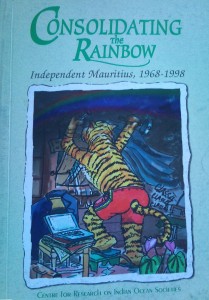





Book Review – Mauritian International Newspaper, March 1999

Mauritian society since Independence
Consolidating the Rainbow: Independent Mauritius 1968-98
Edited by Dr. M. Carter (C.R.I.O.S., Mauritius 1998)
THIS book is the latest in the Rainbow series published by the Centre for Research on Indian Ocean Society’s (CRIOS). The book assesses the development of Mauritian society during the last 30 years through the eyes of several contributors. It reflects the diversity of this island society through analyses and prognoses of contributors of different linguistic and ethnic backgrounds, some of whom write in French.
Consolidating the Rainbow looks at the achievements of Mauritius since independence in 1968, enabling contemporary Mauritian professionals to provide a kaleidoscopic analysis and giving ordinary people a chance to voice their concerns. It opens with a survey of Mauritian politics over the last three decades. Raj Meetarbhan argues that the Mauritians did not fight for independence but were given it on a plate, and precisely because they did not undertake such a nationalist struggle it was not possible for them to forge an identity. Aruna Narain takes stock of the 30-year-old Constitution by looking at its main features and at its more salient amendments. Ari Nave discusses the Best Loser system, caricaturing its absurdity and taking a humourous look at its illogical results by relating the fictional story of the political candidate Li Pa Lee.
‘An Economic Vision’ by Kevin Ramkalaon is more optimistic. In his view, the country’s economy does not need to diversify any further, but rather should shift onto a higher plane. Beena Shah’s article on the other hand, warns that while Mauritius has built a solid foundation in the financial sector, there is no room for complacency. She stresses that in order to remain competitive Mauritians must be proactive.
Proactive perhaps, but we need also to be attentive to and mindful of the environment. Prem Saddul and Jahangeer-Chojoo both discuss the impact of tourism on the island. They are concerned about its impact on the local people and draw attention to both social and environmental effects. They recommend that the future keywords for tourism should be discipline and rigour, restraining “la bétonnisation sauvage” which is threatening the long-term viability of this sector. Tourism also has implications for Mauritians’ health, and this is covered in greater depth by Baboo Ramdowar who provides an overview of health developments since Independence.
Sheila Bunwaree’s article on education demonstrates how the dual system of private and state education in Mauritius privileges the rich and, despite transmitting an ideology of meritocracy, legitimises class inequalities. She suggests the abolition of private tuition, the limitation of the role of religious bodies and socio-cultural organisations in influencing educational policies, and the adoption of a coherent language policy.
A contributor using the initial S.O. provides an overview of events in the domain of communications and the media over the last three decades. He argues that the Mauritian government must soon decide where it is going on the question of “liberalisation des ondes” because whilst the country has benefited from a long-standing independent press, the audio-visual industry is state-run.
Vicram Ramharai considers the issues of language and identity through an assessment of Mauritian literary endeavour, and comes to the positive conclusion that the current generation of writers is “trying hard to set aside racial prejudice, ethnic feelings and language barriers in an attempt to lay the foundation of a national identity.” Similarly, Shawkat Toorawa envisages a Mauritius where individuals are no longer compartmentalised and where there would be a meritocracy untouched by ethnicity. There are essays by artists and students, and the book contains some illustrations.
Consolidating the Rainbow offers great insight into Mauritian society and an opportunity to hear some of its citizens express their opinions on the 30 years since Independence. For anyone wanting to learn more about this young nation state, this book informs on many social aspects, and poses the question can this aspiring Indian Ocean “tiger” rise to meet the challenges facing it?
——————————————————————————————————————————————————–
© C Cuniah
Leave a Reply